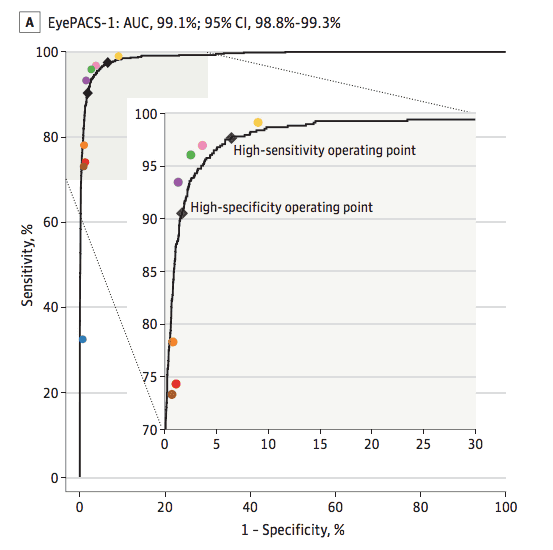Google 's deep learning technology accurately sees eye diseases caused by diabetes better than a specialist

Deep learningDue to the rapid progress of technology, the accuracy of image recognition processing has increased very much. Google has demonstrated better results than specialists in early detection of eye diseases associated with diabetes by utilizing deep learning technology.
Accuracy of a Deep Learning Algorithm for Detection of Diabetic Retinopathy | Diabetic Retinopathy | JAMA | The JAMA Network
http://jamanetwork.com/journals/jama/fullarticle/2588763
Research Blog: Deep Learning for Detection of Diabetic Eye Disease
https://research.googleblog.com/2016/11/deep-learning-for-detection-of-diabetic.html
It occurs as a complication of diabetesDiabetic retinopathyIs the first cause of blindness in adults. Diabetic retinopathy, which is risky of blindness if left alone, is known to be treatable by early detection and it is important to detect the disease as soon as possible to avoid blindness.
In diabetic retinopathy, a spot called "hard vitiligo" that adheres to the retina appears in the early stage, and as it progresses, blood flow in the retina worsens and a mass called "soft leukoplakia" appears and further supplements the ischemia "New blood vessels" which are new blood vessels are made, changes appear in the retina depending on the progress of the disease. Although ophthalmologists can detect the onset of diabetic retinopathy from the state of the retina, absolutely because the number of specialists is not enough, the number of people with diabetes who are going to lose sickness progressing is increasing It is the present condition.

Also, even specialists need experience to see the onset of diabetic retinopathy, it is not easy to do. In order to overcome such a situation, Google's deep learning technology researcher cooperated with 54 ophthalmologists in India and the United States to detect diabetic retinopathy with deep learning using images of 128,000 retinas We did an attempt.
The graph below shows the results of a test that detected 9963 cases of diabetic retinopathy by deep learning developed by Google. The horizontal axis of the graph represents "specificity", which is the probability that the test result is negative (white) when the patient is not ill, and "vertical direction" is "detection sensitivity".

The result is that the algorithm using Google's deep raling is a combination of specificity and detection sensitivityF-scoreHas become the numerical value of "0.95". The number was higher than the average score of eight ophthalmologists "0.91". This research is expressed as "exciting result" by Google Research Blog.
The method of detecting diabetic retinopathy in which image recognition processing by deep learning has been performed this time is merely a method for finding diabetic retinopathy and it is possible not only to further enhance the accuracy of image recognition itself but also to perform other screening Google says that there are many things to do to assist clinical practice of ophthalmologists, such as combining methods.
Related Posts:







